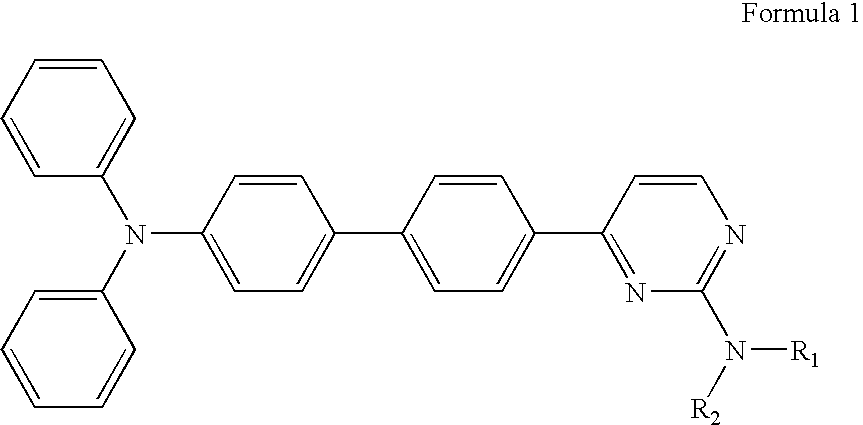Diphenyl amine derivatives having luminescence property
a technology of amine derivatives and luminescence, applied in the direction of luminescent compositions, organic chemistry, chemistry apparatuses and processes, etc., can solve the problems of low luminescence efficiency, low luminescence efficiency, and low efficiency
- Summary
- Abstract
- Description
- Claims
- Application Information
AI Technical Summary
Benefits of technology
Problems solved by technology
Method used
Image
Examples
example 1
Preparation of 1-(4′-diphenylaminobiphenyl-4-yl)ethanone (Formula 4)
[0051]
[0052]4-Bromotriphenylamine (2.0 g, 6.17 mmol), 4-acetylphenylboronic acid (1.12 g, 6.8 mmol), dichlorobis(triphenylphosphine)palladium(II) (130 mg, 0.185 mmol) and sodium carbonate (460 mg, 4.32 mmol) were added into a solvent mixture of acetonitrile and water (1:1, v / v, 80 mL), and heated under nitrogen at 80° C. for 3 hours. After the completion of the reaction, the reaction mixture was cooled to room temperature and added with water (80 mL), followed by the separation of the organic layer with dichloromethane (150 mL×3). The organic layer was filtered, dried and evaporated, and the resulting organic residue was purified by column chromatogram (silica gel, hexane: EtOAc=4:1) to obtain the title compound (1.7 g).
[0053]Yield 76%; mp 97-98° C.; FTIR (KBr, ν / cm−1) 1679, 1590, 1489, 1268, 821, 750, 697; 1H-NMR (300 MHz, CDCl3, ppm) δ 2.65 (s, 3H), 7.08-7.30 (m, 12H), 7.53 (d, J=7.9 Hz, 2H), 7.67 (d, J=7.7 Hz, 2H...
example 2
Preparation of 1-(4′-diphenylaminobiphenyl-4-yl)-3-dimethylaminoprop-2-en-1-one
[0054]
[0055]1-(4′-Diphenylaminobiphenyl-4-yl)ethanone (1.0 g, 2.75 mmol) was reacted with N,N-dimethylformamide dimethylacetal (1.0 g, 8.25 mmol) for 12 hours at 100° C. Non-reacted N,N-dimethylformamide dimethylacetal was removed using a vacuum pump, and water (50 mL) and dichloromethane (100 mL×2) added. The organic layer was separated, filtered, dried and evaporated to obtain the title compound (1.1 g).
[0056]Yield 97%; mp 166-167° C.; FTIR (KBr, ν / cm−1) 1677, 1642, 1591, 1576, 1488, 1273, 1243, 754, 695; 1H-NMR (300 MHz, CDCl3, ppm) δ 2.99 (s, 3H), 3.13 (s, 3H), 5.79 (d, J=12.3 Hz, 1H), 7.06 (t, J=7.2 Hz, 2H), 7.15 (d, J=8.3 Hz, 6H), 7.26-7.32 (m, 4H), 7.52 (d, J=8.6 Hz, 2H), 7.63 (d, J=8.3 Hz, 2H), 7.84 (d, J=12.3 Hz, 1H), 7.98 (d, J=8.3 Hz, 2H); 13C-NMR (75 MHz, CDCl3, ppm) δ 91.87, 92.21, 123.12, 123.62, 124.59, 126.22, 127.84, 128.12, 129.32, 134.13, 138.74, 143.08, 147.58, 147.66, 154.16, 188.08; ...
example 3
Preparation of 4-(4′-diphenylaminobiphenyl-4-yl)pyrimidine-2-amine (compound 1-a)
[0057]
[0058]Sodium ethoxide was prepared by adding sodium (60 mg, 2.63 mmol) into anhydrous ethanol (20 mL), followed by slow addition of guanidine hydrochloride (250 mg, 2.63 mmol) for 1 hour at room temperature. This solution was added with a solution of (4′-diphenylaminobiphenyl-4-yl)-3-dimethylaminoprop-2-en-1-one (1.0 g, 2.39 mmol) in anhydrous ethanol (30 mL), and then refluxed for 12 hours and cooled to room temperature. Precipitated crystals were filtered, washed with cold ethanol and water, and filtered to obtain the title compound in crystalline form.
[0059]Yield 84%; mp 219-220° C.; FTIR (KBr, ν / cm−1) 3483, 3278, 1626, 1589, 1571, 1491, 1459, 1294, 810, 750, 698; 1H-NMR (300 MHz, CDCl3, ppm) δ 6.67 (s, 2H), 7.03-7.11 (m, 8H), 7.16 (d, J=5.2 Hz, 1H), 7.31-7.36 (m, 4H), 7.67 (d, J=8.6 Hz, 2H), 7.76 (d, J=8.3 Hz, 2H), 8.13 (d, J=8.3 Hz, 2H), 8.30 (d, J=5.2 Hz, 1H); 13C-NMR (75 MHz, CDCl3, ppm) δ ...
PUM
| Property | Measurement | Unit |
|---|---|---|
| atmospheric temperature | aaaaa | aaaaa |
| temperature | aaaaa | aaaaa |
| temperature | aaaaa | aaaaa |
Abstract
Description
Claims
Application Information
 Login to View More
Login to View More - R&D
- Intellectual Property
- Life Sciences
- Materials
- Tech Scout
- Unparalleled Data Quality
- Higher Quality Content
- 60% Fewer Hallucinations
Browse by: Latest US Patents, China's latest patents, Technical Efficacy Thesaurus, Application Domain, Technology Topic, Popular Technical Reports.
© 2025 PatSnap. All rights reserved.Legal|Privacy policy|Modern Slavery Act Transparency Statement|Sitemap|About US| Contact US: help@patsnap.com



